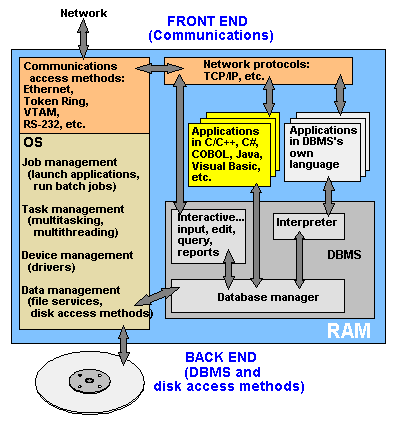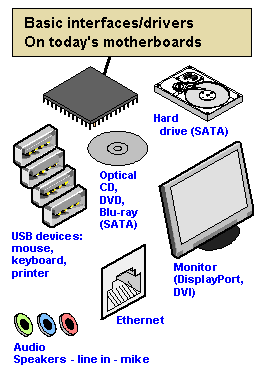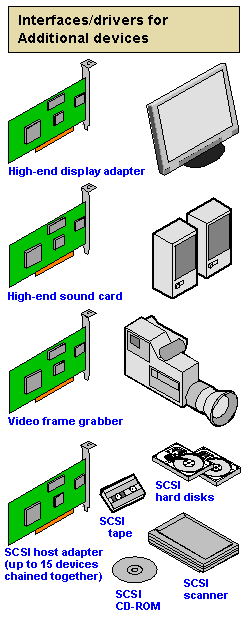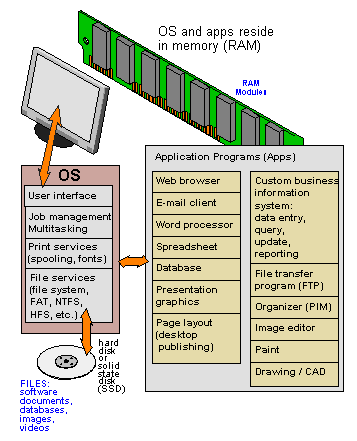
1. INTRODUCTION TO OPERATING SYSTEMS
2. When you turn on your computer, it's nice to think that you're in control. There's the trusty computer mouse, which you can move anywhere on the screen, summoning up your music library or Internet browser at the slightest whim. Although it's easy to feel like a director in front of your desktop or laptop, there's a lot going on inside, and the real man behind the curtain handling the necessary tasks is the operating system .
3. Most desktop or laptop PCs come pre-loaded with Microsoft Windows. Macintosh computers come pre-loaded with Mac OS X. Many corporate servers use the Linux or UNIX operating systems. The operating system (OS) is the first thing loaded onto the computer without the operating system, a computer is useless.
4. More recently, operating systems have started to pop up in smaller computers as well. If you like to tinker with electronic devices, you're probably pleased that operating systems can now be found on many of the devices we use every day, from cell phones to wireless access points. The computers used in these little devices have gotten so powerful that they can now actually run an operating system and applications. The computer in a typical modern cell phone is now more powerful than a desktop computer from 20 years ago, so this progression makes sense and is a natural development.
5. The purpose of an operating system is to organize and control hardware and software so that the device it lives in behaves in a flexible but predictable way. In this module, we'll tell you what a piece of software must do to be called an operating system, show you how the operating system in your desktop computer works and give you some examples of how to take control of the other operating systems around you.
operating system (OS)
Software that controls the operation of a computer, directs the input and output of data, keeps track of files, and controls the processing of computer programs. Its roles include managing the functioning of the computer hardware, running the applications programs, serving as an interface between the computer and the user, and allocating computer resources to various functions. When several jobs reside in the computer simultaneously and share resources (multitasking), the OS allocates fixed amounts of CPU time and memory in turn or allows one job to read data while another writes to a printer and still another performs computations. Through a process called time-sharing, a large computer can handle interaction with hundreds of users simultaneously, giving each the perception of being the sole user. Modern computer operating systems are becoming increasingly machine-independent, capable of running on any hardware platform; a widely used platform-independent operating system in use today on mainframe computers is UNIX. Most personal computers run on Microsoft's Windows operating system, which grew out of and eventually replaced MS-DOS.
operating system
The computer's master control program. When the computer is turned on, a small "boot program" loads the operating system. Although additional system modules may be loaded as needed, the main part, known as the "kernel" resides in memory at all times.
The operating system (OS) sets the standards for all application programs that run in the computer. Applications "talk to" the operating system for all user interface and file management operations. Also called an "executive" or "supervisor," an operating system performs the following functions.
User Interface
All graphics based today, the user interface includes the windows, menus and method of interaction between the user and the computer. Prior to graphical user interfaces (GUIs), all operations were performed by typing in commands. Not extinct today, a command-line interface is included in all major operating systems, and technical operations are commonly executed from the command line by programmers and administrators.
Operating systems may support optional interfaces. Although the overwhelming majority of people work with the default interface, different "shells" offer variations of functionality, and "skins" provide different appearances. See GUI, shell and skin.
Job Management
Job management controls the time and sequence that applications are run. Common in the mainframe and high-end server environment, IBM's job control language (JCL) was developed decades ago to schedule the daily work. The execution of short scripts at specific times throughout the day is common in Unix/Linux servers. In a desktop environment, batch files can be written to perform a sequence of operations that can be scheduled to start at a given time.
Task Management
Multitasking, which is the ability to simultaneously execute multiple programs, is available in all operating systems today. Critical in the mainframe and server environment, applications can be prioritized to run faster or slower depending on their purpose. In the desktop world, multitasking is more often than not "task switching," which keeps applications open so users can bounce back and forth among them. See multitasking.
Data Management
Data management keeps track of the data on disk and other storage devices. The application program deals with data by file name and a particular location within the file. The operating system's file system knows where the data are physically stored (which sectors on disk) and interaction between the application and operating system is through the programming interface (API). When an application needs to retrieve or save data, it makes a call to the operating system's file system, which is in charge of opening, reading, writing and closing files. See API and file system.
Device Management
Device management controls peripheral devices by sending them commands in their proprietary command language. The software routine that deals with each device is called a "driver," and the OS requires drivers for each of the peripherals attached to the computer. When a different type of peripheral is attached, that device's driver must be added to the operating system if not previously installed. See driver.
Security
Operating systems provide password protection to keep unauthorized users out of the system. Operating systems maintain activity logs and may provide time accounting for billing purposes. They also may provide backup and recovery routines for starting over in the event of a system failure.
History
In the 1950s, programmers wrote their own input/output routines to read and write magnetic tape. When magnetic disks came on the scene several years later, it became essential to have a separate program to manage them. In addition, running more than one application at a time (timesharing and multitasking) required a control program to keep track of everything.
Today, all computers from desktops to mainframes use an operating system. Even consumer electronics devices use an OS, whereas in the past, they used custom software that combined OS and application functionality. See embedded Linux.
Common Operating Systems
The primary operating systems in use are Windows (7, Vista and XP), Macintosh OS X, the many versions of Linux and Unix, IBM i (stemming from the midrange AS/400) and z/OS (IBM mainframes). DOS is still used for some applications, and there are other special-purpose operating systems.
Smartphones and tablets use Apple's iOS, Google's Android, RIM's BlackBerry and QNX and Microsoft's Windows Phone.





















0 comments :
Post a Comment